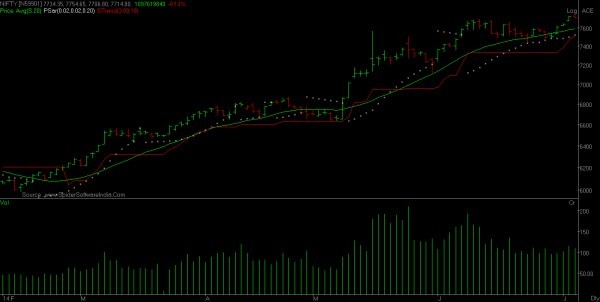The main advantage of Trailing SL is it lets the Winners Run. Remember "Cut your losses and let your profits run" 1st Part (Cutting losses) is taken care by SL and 2nd part (Let profit run) is taken care of by Trailing SL.
Having said that, Trailing SL also has similar pros and cons as regular SL. If it is too close, there is a possibility of early exit and then market continues for bigger moves. Keeping it too wide gives away quite a bit of profit.
Lets look at 3 Trailing SL mechanisms (following 3 are just for illustrative purposes and there could be many more and better Trailing SLs).
1) Parabolic Sar - Initially wide, it moves very fast as the position becomes favorable. This some times causes quick exits and many times market resumes the trend for a big move. Its good for short term trades when one has good re-entry strategy. But for someone who finds difficult to enter the market, may get exited early and miss the big move.
2) 20 SMA - It's move is slower than Parabolic Sar, but with slight consolidation, it may triger exit. Again ok for some one who can re-enter market. But for some one who cannot monitor market as frequently, it may cause miss out on large part of the move.
3) Super Trend - It does not move as fast and hence lets remain in the position for a longer time. In fact it does not move at all when market is consolidating. Yes when market turns around it will give away larger chunk of profit but for people who find difficulty in entering the market or for people who can not monitor day to day, this could be best option.
So each type of Trailing SL has its own advantage and dis-advantage. It is the whole Trading System - combination of Entry Techniques (along with Re-entry Techniques), Exit Strategies (Targets, SL and Trailing SLs), Risk Management and Position Sizing where one factor can make up for advantage/dis-advantage of other factor or it can enhance the other factor, that makes the difference. It is very critical to Back Test and do Walk Forward testing of the entire system to see the results before real trading on it.
Finally one should not move the SL to break even very quickly. Its very common for market to test the prior highs/lows (e.g. double bottom and tops). This could cause an early exit. One should only begin to trail SL once the position moves enough and the probability of re-test decreases.
All the above discussion was about Trailing SL as a strategy.
Attached is chart of Nifty since Feb - ParSar 5 Exits, 20 SMA 2 Exits and Super Trend is yet to trigger. Again this only for illustration purpose.
